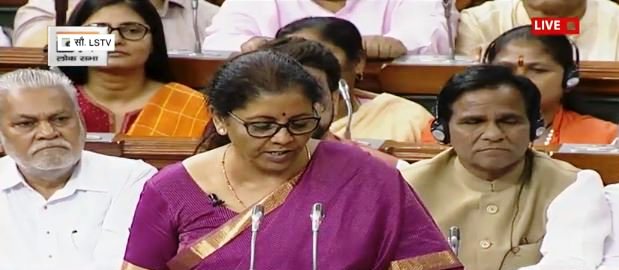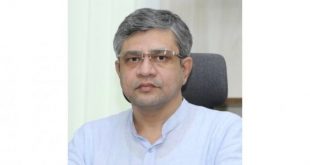New Delhi: “Indian economy will become a 3 trillion dollar economy in the current year and is on the path of achieving the Prime Minister’s vision of a 5 trillion dollar economy by 2024-25”, said Union Finance Minister Nirmala Sitharaman, while presenting the Union Budget 2019-20 in Parliament on Thursday.
It took over 55 years for the Indian economy to reach 1 trillion dollar and in the last 5 years, the government has added 1 trillion dollar to reach about 2.7 trillion dollar. India is now the sixth largest economy in the world, up from 11th position five years ago, she added.
Finance Minister stated that between 2014-19, the Government provided a rejuvenated Centre-State dynamic, cooperative federalism, GST Council, a strident commitment to fiscal discipline and set the ball rolling for a New India, planned and assisted by the NITI Aayog.
Setting pace for the vision for India in the next decade, the Finance Minister stated that mega programmes and services which were initiated and delivered during the last 5 years will now be further accelerated.
The Government plans to simplify procedures, incentivize performance, reduce red-tape and make the best use of technology to achieve the desired goals.
“Gone are the days of policy paralysis and license-quota-control regimes. India Inc. are India’s job-creators. They are the nation’s wealth-creators”, she said while emphasizing the substantial role of India’s private industry in growing our economy.
Citing its genesis in the Interim Budget 2019-20 presented in February 2019, the Finance Minister flagged ten points of the Government’s ‘Vision for the Decade’:
- Building physical and
social infrastructure;
- Digital India reaching every sector of the economy;
- Pollution free India with green Mother Earth and Blue Skies;
- Make in India with particular emphasis on MSMEs, Start-ups, Defence manufacturing, automobiles, electronics, fabs and batteries, and medical devices;
- Water, water management, clean Rivers;
- Blue Economy;
- Space programmes. Gaganyan, Chandrayan and Satellite programmes;
- Self-sufficiency and export of food-grains, pulses, oilseeds, fruits and vegetables;
- Healthy society – Ayushman Bharat, well-nourished women & children. Safety of citizens;
- Team India with Jan Bhagidari. Minimum Government Maximum Governance.
Elaborating on the above points, Finance Minister emphasized on an investment-driven growth model to achieve the goal of 5 Trillion dollar economy. She stated that the Government recognizes that investment-driven growth requires access to low cost capital. It is estimated that India requires investments averaging Rs. 20 lakh crores every year (USD 300 billion a year).
Further, the Finance Minister stated that it is estimated that Railway Infrastructure would need an investment of Rs. 50 lakh crores between 2018-2030.
She proposed to use Public-Private Partnership to unleash faster development and completion of projects and to make available a blueprint this year for developing National Highway Grid, gas grids, water grids, i-ways, and regional airports.
Focusing on unlocking the true potential of Public Sector Undertakings, Finance Minister said that strategic disinvestment of select CPSEs would continue to remain a priority of this Government, along with consolidation of PSUs in the non-financial space. Government is considering, in case where the Undertaking is still to be retained in Government control, to go below 51% to an appropriate level on case to case basis. Government is setting an enhanced target of Rs. 1,05,000 crore of disinvestment revenue for the financial year 2019-20, she added.
To prepare India’s youth to also take up jobs overseas, Finance Minister said that the Government will increase focus on skillsets needed abroad including language training.
Focus would be laid on new-age skills like Artificial Intelligence (AI), Internet of Things, Big Data, 3D Printing, Virtual Reality and Robotics, which are valued highly both within and outside the country, and offer much higher remuneration, she added.
 Update Odisha-Latest Odisha News I Breaking News Get latest news on Odisha, Govt. Jobs, OSSC, OPSC, Entertainment, Crime, Sports, and Education
Update Odisha-Latest Odisha News I Breaking News Get latest news on Odisha, Govt. Jobs, OSSC, OPSC, Entertainment, Crime, Sports, and Education



